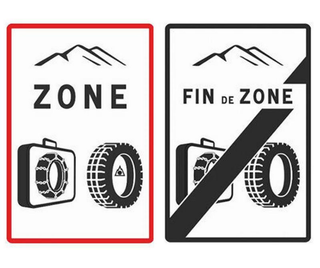Winter Driving Advice
Winter Driving Tips in France: A Guide for a Safe Journey
Winter is a magical time to explore France, from the snow-capped Alps to charming villages blanketed in frost. However, driving in winter conditions require preparation and caution to ensure a smooth and safe journey. Whether you're heading to a ski resort or enjoying a festive road trip, here are some essential winter driving tips to consider.
1. Prepare Your Vehicle
Before setting off, make sure your car is winter-ready:
- Winter Tyres or Chains: Winter tyres are mandatory in many mountainous regions of France between 1st November and 31st March. Carry snow chains if you're heading to the Alps or Pyrenees, as they might be required in heavy snow. See the next section. More information can be found here.
- Check Your Battery: Cold weather can drain your car battery faster so ensure it is in good condition.
- Top Up Fluids: Use winter-grade windshield washer fluid suitable for -20 degrees to prevent freezing.
- Inspect Wipers and Lights: Replace worn wiper blades and ensure all lights are functioning to improve visibility in fog, snow, or rain.
2. Understand French Winter Driving Rules
French regulations vary depending on the region:
- Mountain Areas: In addition to winter tyres, some roads may require snow chains or socks during snowfall. Look for signs reading *"Équipements spéciaux obligatoires"* (special equipment required). Tyres with only the M+S (Mud + Snow) marking are no longer accepted. Only 3PMSF tyres are accepted as equivalent to chains (3PMSF is the acronym for "Three peak mountain snow flake"). Other winter tyres can be used but only in conjunction with chains/snow socks. More information for different areas can be found here.
- Speed Limits: Adjust your speed according to weather conditions. Lower limits may apply in adverse weather.

3. Essential Supplies for Winter Journeys
Carry a winter emergency kit in case of delays or breakdowns:
- Ice scraper and de-icer
- Warm blankets and extra clothing
- Flashlight with spare batteries
- High-energy snacks and water
- First-aid kit
- Portable phone charger
4. Plan Your Route Carefully
Check the weather forecast and road conditions before setting out. Websites such as Bison Futé provide real-time traffic updates in France. Avoid minor mountain roads during heavy snowfall and opt for major routes, which are often better maintained.
5. Adapt Your Driving Style
Driving on snow and ice requires extra caution:
- Slow Down: Reducing speed gives you more control and reaction time.
- Maintain Safe Distances: Increase the gap between your car and others to allow for longer braking distances.
- Avoid Sudden Movements: Gentle acceleration, steering, and braking will help you maintain traction.
- Use Low Gears on Descents: This helps to avoid overheating your brakes on slippery slopes.
6. Know What to Do in an Emergency
If you encounter trouble:
- Stay Visible: Use your hazard lights and reflective warning triangle.
- Stay Warm: Keep the engine running periodically to maintain heat but ensure the exhaust is clear of snow.
- Call for Assistance: Keep emergency numbers handy. In France, dial 112 for immediate help.
7. Consider an Emovis Tag for Smooth Travel
Winter driving in France often means passing through toll roads, especially on routes to ski resorts. An Emovis Tag allows you to use the automatic Télépéage lanes, reducing waiting times at toll booths – particularly valuable during peak holiday periods when the weather might be challenging.
Final Thoughts
Driving in wintery France is a rewarding experience, offering breath-taking landscapes and unique adventures. By preparing your car, understanding local regulations, and adapting your driving habits, you can make your winter road trip safe and enjoyable.
Stay safe, plan ahead, and enjoy the wonders of winter in France!